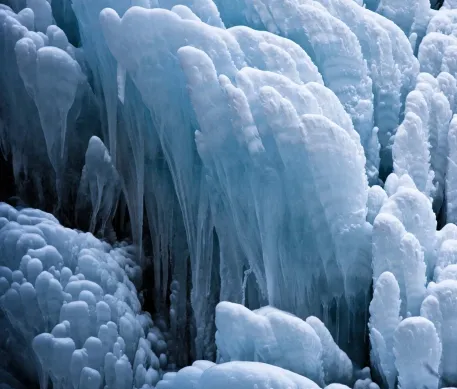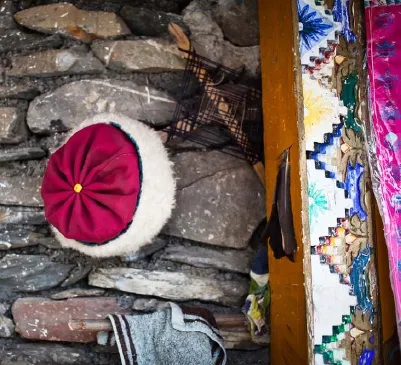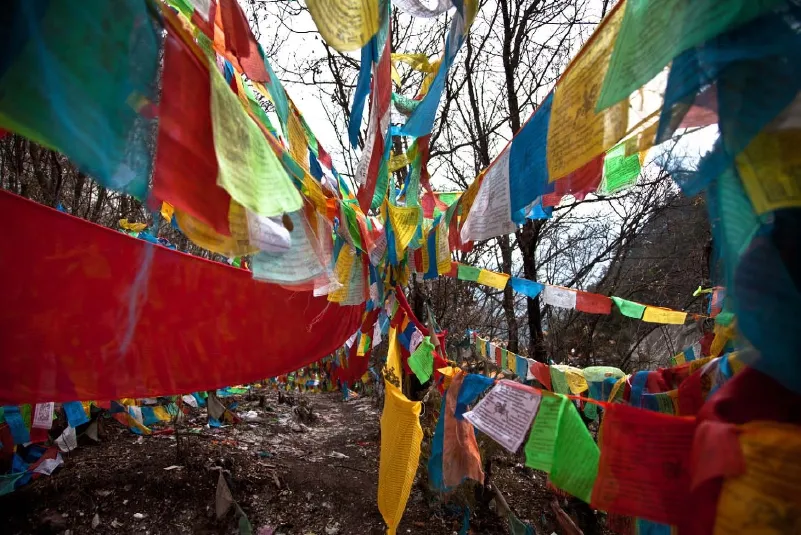FROZEN FALLS
FROZEN FALLS
PHOTOGRAPHS AND TEXT BY ALICE CARFRAE
A frozen landscape and warm company on the edge of the Himalayan Plateau
冬日里九寨溝寂靜無人的冰雪天堂
18

Jiuzhaigou (九寨溝) is located on the edge of the Tibetan Himalayan Plateau in northern Sichuan Province. With its sparkling turquoise lakes, spectacular waterfalls, and unique wildlife, it is a popular destination for mainland tourists. Almost all of them visit in the summer months; in the winter, this stunning UNESCO world heritage site is a virtually deserted wilderness—a true winter wonderland.
Jiuzhaigou literally translates as “Nine Village Valley”and takes its name from the nine Tibetan villages dotted along its length. Due to modernization, only seven of the nine villages are populated today. After exploring the stunning scenery that Jiuzhaigou has to offer, I decided to stay in one of the less touristy villages on the outskirts of the park.
I was warmly welcomed at “Zohma's Homestay” by Zohma's elderly mother who is affectionately known as Amma. Zohma is a local entrepreneur who hosts this family run home-stay. Amma greeted me with a smile as wide as the Pearl Falls (珍珠灘瀑布) that I had been exploring in the park. She speaks little English but communicates with an infectious laugh and wide smile. She ushered me in from the cold, as yak butter tea simmered away in a large pot on the stove. For those not keen on the rich and salty yak tea there was a large kettle full ofchang, or barley wine, and Amma made sure that nobody's cup was half empty, even for a second.
That night I was joined around the stove by other guests and Zohma herself who serenaded us with hauntingly beautiful Tibetan folk songs. The endless ref i lls of barley wine left us all glowing as brightly as the embers of the stove.
The next day I decided to take a horse trek through the village, although my horse turned out to be more of a stubborn, stubby-legged pony than anything else. I made my way, along traditional wooden and stone houses that perch on the steep hillsides, to a mountain-top shrine that is sacred to the local people. My guide took some thin paper prayer sheets out from his pocket and threw them into the wind, which carried them up into the a sky that was fast turning an ominous black. Our trek was cut short as the guide decided we should head for home as snow had already begun falling. A biting wind picked up, and icy snow that was more like hail, lashed my face making it hard to see. It was a reminder of just how wild this beautiful but unforgiving landscape can be. The guide did a good job of navigating our way down the mountainside, and waiting for us at the doorway of the guesthouse was Amma with warm towels, yak butter tea, and an even warmer smile.

REED LAkE IS A REED-COVERED MARSH WITH A CLEAR TURQUOISE BROOk ZIGZAGGING THROUGH IT

A LOCAL GUIDE HELPED NAVIGATE OUR WAY DOWN THE MOUNTAIN, BACk TO THE WARMTH OF THE GUESTHOUSE

ZOHMA'S MOTHER “AMMA”, AS SHE IS AFFECTIONATELY kNOWN, HANGS HER HAT ON THE STONE WALL OF THEIR SMALL GUESTHOUSE

MY GUIDE HOLDS THE REIGNS OF THE SMALL PONY THAT CARRIED ME THROUGH THE VALLEY

CHILDREN FROM THE LOCAL SCHOOL HURRY HOME AS IT BEGINS TO SNOW

JOSS STICkS MADE FROM TRADITIONAL TIBETAN INCENSE BURN IN THE ZHARU MONASTERY

PRAYER FLAGS DECORATE A SACRED SPOT OUTSIDE THE ZHARU MONASTERY IN JIUZHAIGOU

